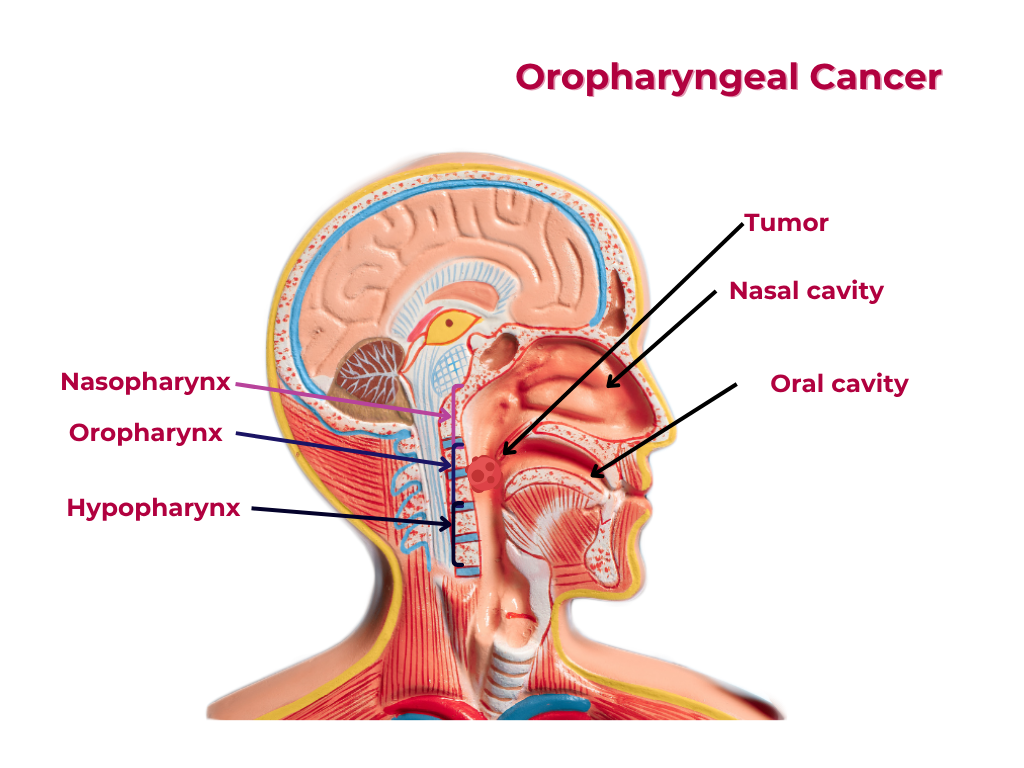
Overview
Carcinoma of the oropharynx refers to a malignant tumor that arises from the epithelial cells lining the oropharynx. It is a type of head and neck cancer that affects the oropharynx, which includes the base of the tongue, tonsils, soft palate, and pharyngeal walls.
Anatomy of the Oropharynx
The oropharynx is the middle part of the pharynx (throat) and includes:
1. Base of the tongue: The posterior part of the tongue.
2. Tonsils: Lymphoid tissue on either side of the oropharynx.
3. Soft palate: The soft tissue at the back of the roof of the mouth.
4. Pharyngeal walls: The lateral and posterior walls of the oropharynx.
Epidemiology
Oropharyngeal cancer is more common in men than women, and the incidence is increasing, particularly in younger patients. Risk factors include tobacco and alcohol use, as well as human papillomavirus (HPV) infection.
Pathophysiology
Oropharyngeal carcinomas are typically squamous cell carcinomas, arising from the epithelial cells lining the oropharynx.
Aetiological Factors
-
1. Tobacco and alcohol use:
Major risk factors for oropharyngeal cancer.
-
2. HPV infection:
Particularly HPV-16, which is associated with a distinct subtype of oropharyngeal cancer.
-
3. Other factors:
Poor oral hygiene, diet, and genetic predisposition may also play a role.
Special Role of HPV in Oropharyngeal Carcinoma
HPV-positive oropharyngeal carcinomas have distinct clinical and pathological features, including:
-
1. Better prognosis:
HPV-positive tumors tend to have a better prognosis than HPV-negative tumors
-
2. Different demographics:
HPV-positive tumors are more common in younger patients and those with a history of oral sex.
Diagnosis
Symptoms and signs
Common symptoms and signs include:
1. Sore throat: Persistent sore throat or discomfort
2. Dysphagia: Difficulty swallowing.
3. Otalgia: Ear pain.
4. Weight loss: Unintentional weight loss.
5. Neck mass: A lump in the neck.
Differential Diagnosis of Carcinoma of Oropharynx
Other conditions that may mimic oropharyngeal cancer include:
-
1. Tonsillitis:
Inflammation of the tonsils.
-
2. Pharyngitis
Inflammation of the pharynx.
-
3. Other head and neck cancers:
Such as cancers of the oral cavity or hypopharynx.
Investigations
-
1. Clinical examination:
A thorough examination of the oropharynx and neck.
-
2. Biopsy:
A tissue sample is taken for histopathological examination.
-
3. Imaging studies:
CT, MRI, or PET scans may be used to assess the extent of the tumor.
Types of Biopsies
1. Incisional biopsy: A sample of tissue is taken from the tumor.
2. Excisional biopsy: The entire tumor is removed for examination.
Prognostic Factors
-
1. HPV status:
HPV-positive tumors tend to have a better prognosis.
-
2. Tumor stage:
Early-stage tumors have a better prognosis than advanced-stage tumors.
-
3. Patient factors:
Age, performance status, and comorbidities can influence prognosis.
TNM Classification
The TNM classification system is used to stage oropharyngeal cancer, taking into account the size and extent of the tumor (T), lymph node involvement (N), and distant metastasis (M). The classification system differs for HPV-positive and HPV-negative tumors.
HPV-Negative / HPV-Unknown Oropharyngeal Carcinoma
The TNM classification system for HPV-negative oropharyngeal carcinoma is similar to the traditional TNM system used for other head and neck cancers.
This classification system helps predict prognosis and guide treatment decisions for patients with HPV-negative oropharyngeal carcinoma.
T Category
-
1. T1:
Tumor ≤ 2 cm in greatest dimension.
-
2. T2:
Tumor > 2 cm but ≤ 4 cm in greatest dimension.
-
3. T3:
Tumor > 4 cm in greatest dimension or extension to lingual surface of epiglottis.
-
4. T4:
Tumor invades any of the following: larynx, extrinsic muscle of tongue, medial pterygoid, hard palate, or mandible.
- T4a: Tumor invades the larynx, extrinsic muscle of tongue, medial pterygoid, hard palate, or mandible.
- T4b: Tumor invades the lateral pterygoid muscle, pterygoid plates, or skull base.
N Category
-
1. N0:
No regional lymph node metastasis.
-
2. N1:
Metastasis in a single ipsilateral lymph node, ≤ 3 cm in greatest dimension.
-
3. N2:
Metastasis in a single ipsilateral lymph node, > 3 cm but ≤ 6 cm in greatest dimension, or in multiple ipsilateral lymph nodes, none > 6 cm in greatest dimension, or in bilateral or contralateral lymph nodes, none > 6 cm in greatest dimension.
- N2a: Metastasis in a single ipsilateral lymph node > 3 cm but ≤ 6 cm in greatest dimension.
- N2b: Metastasis in multiple ipsilateral lymph nodes, none > 6 cm in greatest dimension.
- N2c: Metastasis in bilateral or contralateral lymph nodes, none > 6 cm in greatest dimension.
-
4. N3:
Metastasis in a lymph node > 6 cm in greatest dimension.
M Category
1. M0: No distant metastasis.
2. M1: Distant metastasis.
Stage Grouping
The stage grouping for HPV-negative oropharyngeal carcinoma is as follows:
1. Stage I: T1 N0 M0.
2. Stage II: T2 N0 M0.
3. Stage III: T3 N0 M0 or T1-3 N1 M0.
4. Stage IV: T4 N0-1 M0 or any T N2-3 M0 or any T any N M1.
- Stage IVA: T4a N0-2 M0 or any T N2 M0.
- Stage IVB: T4b any N M0 or any T N3 M0.
- Stage IVC: Any T any N M1.
HPV-Positive Oropharyngeal Carcinoma
The TNM classification system for HPV-positive oropharyngeal carcinoma is similar to the traditional TNM system, but with some modifications to reflect the unique biology and prognosis of HPV-positive tumors.
This classification system reflects the better prognosis of HPV-positive oropharyngeal carcinoma compared to HPV-negative tumors.
T Category
-
1. T1:
Tumor ≤ 2 cm in greatest dimension.
-
2. T2:
Tumor > 2 cm but ≤ 4 cm in greatest dimension.
-
3. T3:
Tumor > 4 cm in greatest dimension or extension to lingual surface of epiglottis.
-
4. T4:
Tumor invades any of the following: larynx, extrinsic muscle of tongue, medial pterygoid, hard palate, or mandible.
N Category
The N category for HPV-positive oropharyngeal carcinoma is different from the traditional N category. The new classification system is based on the number and size of lymph nodes involved:
-
1. N0:
No regional lymph node metastasis.
-
2. N1:
Metastasis in a single or multiple ipsilateral lymph node, < 6 cm in greatest dimension.
-
3. N2:
Metastasis Contralateral or bilateral < 6cm
-
4. N3:
Metastasis in a lymph node > 6 cm in greatest dimension.
M Category
1. M0: No distant metastasis.
2. M1: Distant metastasis.
Stage Grouping
The stage grouping for HPV-positive oropharyngeal carcinoma is as follows:
1. Stage I: T1-2 N0-1 M0.
2. Stage II: T1-2 N2 M0 or T3 N0-2 M0.
3. Stage III: T4 N0-2 M0 or any T N3 M0.
4. Stage IV: Any T any N M1.
Management
-
1. Surgery:
Surgical resection of the tumor and affected lymph nodes.
-
2. Radiotherapy:
External beam radiation therapy or brachytherapy.
-
3. Chemotherapy:
May be used in combination with radiation therapy.
-
4. Combination therapy:
A combination of surgery, radiation, and chemotherapy may be used.
Note on Commando Operation
A commando operation is a type of surgical procedure that involves resection of the oropharynx, mandible, and neck dissection. It is a complex procedure that requires careful planning and reconstruction.
Carcinoma of the oropharynx, is a complex disease that requires a multidisciplinary approach to management. Understanding the role of HPV in oropharyngeal cancer and the different prognostic factors can help guide treatment decisions and improve patient outcomes.
Share Post On:
Recent Posts
-
Nuggets of ORL-RHINOLOGY
-
Nuggets of Otorhinolaryngology-Basic sciences
-
Anatomy of the Muscles of the Soft Palate
-
Ethmoidal Arteries Ligation for Epistaxis
-
Submucous Cleft Palate (SMCP)
-
Approach to Ligation of the External Carotid Artery
-
Approach to Managing a 3-Year-Old Boy with a Foreign Body in the nasal cavity.
-
Approach to Managing a 3-Year-Old Boy with a Foreign Body impacted in the ear canal.
-
Endoscopic Sphenopalatine Artery Ligation (ESPAL) for Epistaxis
-
Surgical Management of Epistaxis
-
Technique of Incision and Drainage of Septal Hematoma/Septal Abscess
-
Upper Aerodigestive Tract Foreign Body Impaction
-
Incision and Drainage of Hematoma Auris
-
Rigid Bronchoscopy for Retrieval of Foreign Bodies in Children
-
Foreign Body Impaction in the Larynx, Trachea, and Bronchi
-
Leadership Position is a Tool, not a Trophy
-
Carcinoma of the Oropharynx
-
Peritonsillar Abscess
-
Ethics of Doctor-Patient Relationship
-
Doctor-Patient Relationship Case Scenarios
-
Asymmetrical Tonsils and Approach to Evaluation and Management
-
Nasal Polyposis
-
Rigid Oesophagoscopy and Complication
-
Anatomy of Oesophagus
-
Stridor, Snoring, Stertor And Wheezing: How They Compare
-
Temporomandibular Joint (TMJ)
-
Otoacoustic Emissions
-
Tympanometry
-
Functional Endoscopic Sinus Surgery (FESS)
-
Tracheostomy
-
Clinical Voice Test (CVT) for Hearing Loss
-
Acute Epiglottitis And Approach To Management
-
Synoptic Overview Of Nasopharyngeal Carcinoma
-
Prioritizing Support For People With Disabilities Over Unhealthy Competitions That Marginalise The Downtrodden
-
Otitic Barotrauma
-
Titbits of Informed Consent Process for a Medical or Surgical Procedure
-
Comprehensive Overview of Mpox (Monkeypox)
-
Overview Of Corrosive Ingestion - Acid & Alkalis, and Management Approach
-
Ethical Conundrum
-
Comprehensive Overview of Laryngeal Papillomatosis and HPV Virus
-
All You Need To *Know About Gardasil*
-
Preauricular Sinus
-
Laryngomalacia - comprehensive overview
-
Flexible Laryngoscopy features of Laryngomalacia
-
Case Report of a Rare Cause of Upper Airway Obstruction In Adults
-
Usefulness of The Neck Soft Tissues X-Ray
-
Paranasal Sinuses Radiology
-
Swallow Function Test
-
Radiotherapy and Chemotherapy In Head And Neck Cancers
-
Myringoplasty
Categories
Get in Touch
Read doctor-produced health and medical information written for you to make informed decisions about your health concerns.

